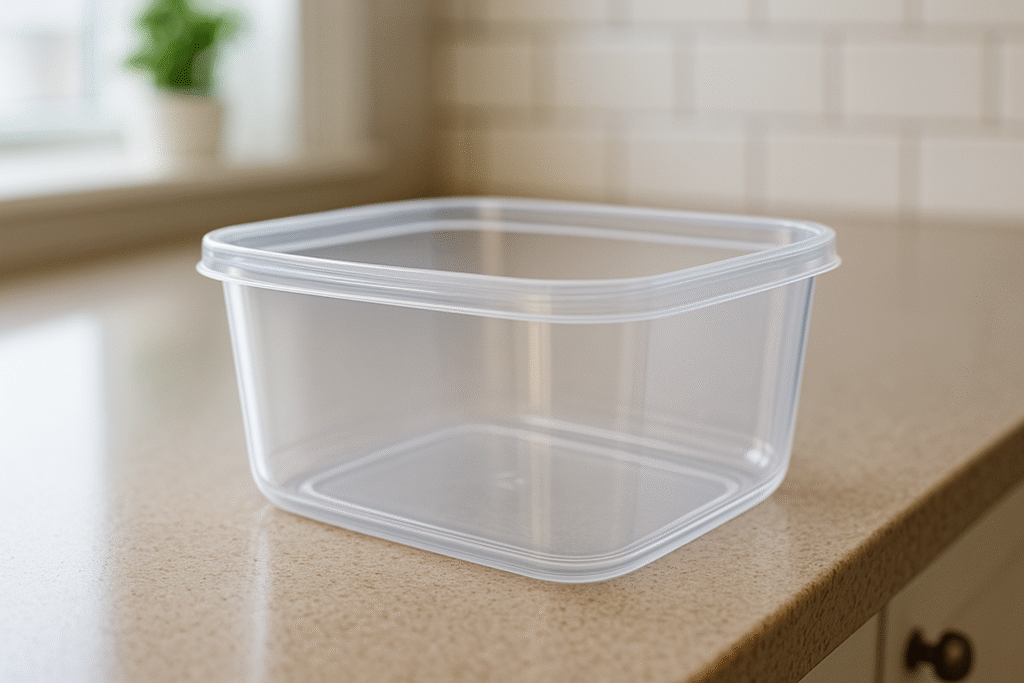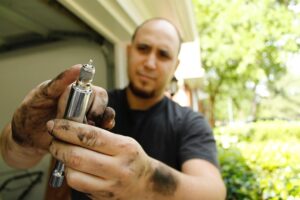Introduction
If you’ve ever peeled a label, sticker, or piece of tape off a plastic surface, you’ve likely been left with a frustrating, sticky mess that seems impossible to clean. Knowing how to get sticky residue off plastic is essential for restoring containers, electronics, furniture, and countless other household items. The residue not only looks unpleasant but can also attract dirt, dust, and grime, making the surface look even worse over time. Whether it’s packaging tape on storage bins or old price stickers on kitchenware, adhesive buildup is one of the most common annoyances homeowners face.
The problem with sticky residue is that it often resists normal cleaning. Wiping with water or soap rarely does the trick, and scrubbing too hard can scratch or damage the plastic. Some adhesives harden over time, becoming even more stubborn and leaving behind a cloudy film. Learning how to get sticky residue off plastic effectively requires knowing which methods work safely without harming the material. The wrong approach could cause more harm than good, especially if you’re working with clear or delicate plastic items.
Fortunately, there are many proven solutions for this problem. From simple household items like cooking oil and vinegar to specialized adhesive removers, there are safe and effective ways to tackle sticky messes. The trick is to match the method to the type of plastic and adhesive involved. By understanding the right steps, you can avoid frustration and restore surfaces to their original clean condition. Once you know how to get sticky residue off plastic, you’ll save money, reduce waste, and extend the life of your household items.
In this guide, we’ll explore why sticky residue is such a problem, the mistakes people often make when trying to remove it, and step-by-step methods that really work. We’ll also cover common questions and offer preventive tips to help you avoid sticky messes in the first place. By the end, you’ll feel confident in your ability to handle any adhesive-related issue and keep your plastic surfaces looking spotless.
Why Sticky Residue on Plastic Is a Problem
Sticky residue may seem like a minor inconvenience, but anyone who has dealt with it knows how persistent and frustrating it can be. The challenge of figuring out how to get sticky residue off plastic lies in the way adhesives bond with the material. Many labels, tapes, and stickers use pressure-sensitive adhesives that seep into the microscopic pores of plastic. When the top layer is peeled away, remnants stay behind, clinging tightly to the surface. Over time, this residue hardens, collects dirt, and leaves an unsightly cloudy film that can make even new items look old and neglected.
Beyond appearances, sticky residue causes practical issues. Plastic storage containers with leftover adhesive can feel tacky to the touch, making them unpleasant to use. Electronics and remotes often suffer from adhesive buildup, which can trap dust and grime, interfering with buttons and vents. Even furniture and decorative items lose their appeal when marred by sticky spots. That’s why knowing how to get sticky residue off plastic is about more than aesthetics—it’s also about functionality and hygiene. Adhesive attracts bacteria and dirt, meaning uncleaned surfaces could eventually pose a sanitary problem.
Another reason this problem is so common is that people tend to underestimate the durability of adhesives. Basic cleaning with soap and water rarely works because these substances are designed to resist moisture. Instead, improper cleaning methods like excessive scrubbing or scraping can scratch and permanently damage plastic. Clear plastics are especially vulnerable, as scratches can leave them hazy and reduce transparency. Without the right approach, the attempt to fix the problem often creates new damage, making it even harder to restore the surface to its original state.
Finally, sticky residue can reduce the lifespan of items. Plastic bins, kitchenware, and household tools that look and feel dirty are often discarded prematurely, even though they are still functional. This not only leads to unnecessary waste but also costs money in replacements. By learning how to get sticky residue off plastic properly, you can maintain your items longer, save money, and reduce waste. The persistence of sticky residue is why so many people seek out reliable, safe, and effective solutions to restore their plastics.
Common Mistakes People Make When Removing Sticky Residue from Plastic
When people try to figure out how to get sticky residue off plastic, they often rush into using harsh or incorrect methods that make the situation worse. One of the most common mistakes is scrubbing the residue with abrasive pads or steel wool. While these might seem like a quick fix, they scratch the plastic surface, leaving permanent marks that are far more noticeable than the original sticky patch. Clear or glossy plastics are especially vulnerable, and once scratched, they can never be fully restored to their original shine.
Another frequent error is applying strong chemical cleaners without checking if they are safe for plastic. Solvents like acetone or nail polish remover can sometimes dissolve adhesives, but they also eat into plastic surfaces, leaving behind dull spots or causing them to warp. Even rubbing alcohol, which is safer, can cause cloudiness if used excessively on certain plastics. People who are too eager to remove residue often overlook the importance of testing a small, hidden area before applying any cleaner to the main surface.
Many people also make the mistake of relying solely on scraping tools like knives or razor blades. While these can sometimes lift adhesive, they often gouge the plastic and create deep scratches that ruin the surface. Plastic is softer than metal, meaning it doesn’t take much pressure to cause damage. A safer alternative is to use plastic scrapers or old credit cards that are rigid enough to lift residue but gentle enough not to scar the material. Forgetting this precaution is one of the main reasons people fail when learning how to get sticky residue off plastic.
Lastly, a big mistake is skipping patience and rushing the process. Sticky residue often needs time to soften before it can be removed effectively. People who spray on a cleaner and wipe it off immediately usually find the adhesive still clinging to the surface. Allowing oil, vinegar, or a safe adhesive remover to soak into the residue makes the job far easier. Skipping this step not only wastes effort but also increases the risk of damaging the plastic with excessive force. Avoiding these common mistakes ensures your cleaning process is safe, effective, and preserves the quality of your items.
Step-by-Step Guide: How to Get Sticky Residue Off Plastic
Step 1: Loosen Residue with Heat or Oil
The first step in learning how to get sticky residue off plastic is to soften the adhesive so that it becomes easier to remove. Many adhesives harden over time and stick more firmly to plastic surfaces, making them resistant to simple wiping. Applying heat or oil is one of the safest and most effective ways to begin loosening the residue without harming the plastic itself. Both of these approaches work by breaking down the adhesive’s bond and making it more pliable for removal.
Heat works well for stickers, labels, and tape residue. Using a hairdryer on a medium setting, aim warm air directly at the sticky spot for 30–60 seconds. This softens the adhesive, allowing you to peel or gently scrape it away. Always keep the hairdryer moving to avoid overheating or warping the plastic, especially with thinner materials. Heat is particularly effective for large adhesive patches that cover a wide area, as it loosens the bond uniformly across the surface.
If you prefer a chemical-free approach, oils are an excellent alternative. Substances like olive oil, coconut oil, or even peanut butter can be applied directly to the sticky residue. Oils seep into the adhesive, weakening its grip on the plastic. Let the oil sit for 10–15 minutes, then wipe away the softened residue with a cloth. This method is safe for most plastics, though you’ll need to wash the surface afterward with mild soap and water to remove any oily film.
Heat and oil can also be combined for tougher residue. For example, warming the plastic with a hairdryer first and then applying oil often speeds up the loosening process. Regardless of which method you choose, patience is key. Allowing time for the adhesive to soften will make the next steps much easier. By starting with heat or oil, you set yourself up for success in removing sticky buildup without damaging your plastic items, ensuring you handle how to get sticky residue off plastic the right way.
Step 2: Use Safe Cleaners for Plastic
After loosening the adhesive with heat or oil, the next step in how to get sticky residue off plastic is applying a cleaner that safely dissolves the remaining residue. While the initial softening often removes a large portion of the sticky mess, there are usually stubborn traces left behind. Choosing the right cleaner is crucial—use something strong enough to cut through adhesives but gentle enough not to damage the plastic surface. This balance ensures the plastic is restored to a smooth, clean finish without scratches, discoloration, or clouding.
One of the most accessible and effective options is rubbing alcohol (isopropyl alcohol). Apply a small amount to a soft cloth or cotton ball and gently rub the residue in circular motions. Alcohol works by breaking down the adhesive’s chemical structure, lifting it away from the plastic. Because it evaporates quickly, it doesn’t leave a lasting mark or oily film, making it a reliable option. For thicker residue, let the alcohol sit on the surface for a minute before wiping. This method is safe for most plastics, though it’s always smart to test a hidden spot first.
Vinegar is another safe, natural cleaner that works well on sticky messes. Its mild acidity helps dissolve adhesives, making it a great choice for kitchenware and food containers. To use vinegar, soak a cloth in white vinegar, place it over the residue, and let it sit for 10–15 minutes before wiping away. Vinegar is non-toxic, eco-friendly, and particularly useful for items that come into contact with food. This makes it a go-to option for households that prefer natural cleaning solutions.
For commercial alternatives, adhesive removers like Goo Gone are specially formulated to tackle sticky residues without harming plastics. Apply a small amount directly to the spot, let it penetrate for a few minutes, and then wipe clean. These products are especially effective for tough residues left behind by strong industrial adhesives or duct tape. However, because they can leave behind a slight oily finish, it’s best to wash the surface with soap and water afterward. By using these safe and targeted cleaners, you ensure the second step of how to get sticky residue off plastic is effective, restoring the surface without risk of damage.
Step 3: Prevent Sticky Residue in the Future
Once you’ve successfully cleaned your items, the final part of how to get sticky residue off plastic is learning how to prevent it from coming back. Sticky residue often forms when tape, stickers, or labels are left on plastic for too long, allowing the adhesive to harden and bond deeply with the surface. By taking a few simple precautions, you can save yourself time and effort in the future while keeping your plastic items in excellent condition.
One of the most effective preventive strategies is to remove labels or tape as soon as they are no longer needed. Adhesives are easiest to peel off when they’re fresh. The longer they sit, the more they fuse with the plastic, making removal harder later on. For new purchases, such as plastic containers or appliances, take a moment to peel off stickers immediately instead of letting them linger. If a sticker doesn’t come off cleanly, apply a little heat with a hairdryer right away to loosen it before it sets in permanently.
Another way to prevent sticky residue is by choosing the right type of adhesive products. When labeling storage containers, opt for removable or washable labels rather than permanent ones. Painter’s tape or masking tape is also much less likely to leave sticky traces compared to packaging tape or duct tape. If you frequently need to label items, investing in reusable plastic tags or erasable markers is a great long-term solution that avoids adhesives altogether.
Finally, consider applying a protective barrier to plastic surfaces. A light coating of cooking spray, mineral oil, or even furniture polish can create a slick layer that prevents adhesives from bonding tightly. While this may not be practical for every item, it’s especially helpful for reusable containers or bins that often get labeled. Regular cleaning also plays a role—keeping plastics free of grease and dust reduces the chances of adhesives sticking aggressively. By adopting these preventive measures, you not only learn how to get sticky residue off plastic but also how to stop it from becoming a recurring nuisance, extending the life and appearance of your household items.
FAQs About How to Get Sticky Residue Off Plastic
Can sticky residue damage plastic permanently?
Sticky residue itself doesn’t usually damage plastic, but the methods used to remove it often can. For example, aggressive scrubbing with steel wool or razor blades can scratch the surface permanently, while harsh solvents like acetone may cause clouding or warping. That’s why it’s important to know how to get sticky residue off plastic using safe techniques. If addressed properly with oils, vinegar, or rubbing alcohol, residue can be removed without leaving lasting marks, keeping the plastic in good condition.
What household items can I use to remove sticky residue from plastic?
Many common household items are surprisingly effective at tackling sticky messes. Cooking oils like olive or coconut oil can loosen adhesives, while vinegar dissolves sticky buildup naturally. Baking soda paste works well for scrubbing without scratching. Even peanut butter has been used to soften tough adhesive patches. If you’re figuring out how to get sticky residue off plastic without buying commercial cleaners, these simple solutions are budget-friendly and safe for most surfaces. Always remember to wash the plastic with mild soap afterward to remove any oily film.
Is rubbing alcohol safe for all plastics?
Rubbing alcohol (isopropyl alcohol) is one of the most reliable options for adhesive removal, but it should still be used with caution. While it works on most plastics, prolonged contact may cause clouding on softer or transparent surfaces. To safely use it when learning how to get sticky residue off plastic, apply it with a cloth or cotton ball instead of pouring it directly onto the item. Test a hidden area first, and if no discoloration occurs, proceed with the sticky spot. Used sparingly, rubbing alcohol is both safe and effective.
Why does sticky residue attract dirt and dust?
Adhesive residue stays tacky even after the sticker or tape is removed, which causes it to collect dirt, dust, and lint over time. This makes the surface appear dirty and can even feel unpleasant to the touch. That’s why knowing how to get sticky residue off plastic is about more than appearances—it’s also about hygiene. Dirty residue can harbor bacteria, especially on items like food containers or toys. Removing the stickiness ensures the plastic stays clean, safe, and more enjoyable to use.
How can I prevent sticky residue when labeling plastic containers?
The best prevention strategy is to avoid permanent adhesives altogether. Instead of duct tape or packaging tape, use painter’s tape, masking tape, or removable labels that are designed to peel away cleanly. You can also use erasable markers on smooth plastic surfaces or invest in clip-on tags for storage bins. By adopting these alternatives, you won’t have to constantly figure out how to get sticky residue off plastic. Preventing adhesive buildup in the first place saves time, keeps items cleaner, and prolongs the life of your plastic containers.
Conclusion
Sticky labels, tape, and adhesives may seem harmless, but they leave behind frustrating residue that can be tough to clean. Fortunately, once you know how to get sticky residue off plastic, restoring your items becomes a simple and effective process. By starting with heat or oil to soften the adhesive, moving on to safe cleaners like vinegar, rubbing alcohol, or commercial removers, and finishing with preventive habits, you can tackle any sticky mess with confidence. These methods save time, protect your items from scratches, and help you avoid the waste of replacing plastic that still has plenty of life left in it.
Prevention is just as important as cleaning. By removing labels promptly, choosing removable adhesives, or applying protective barriers, you stop residue before it even becomes a problem. Once you understand the right tools and approaches, you’ll never have to struggle with cloudy films or tacky surfaces again. Mastering how to get sticky residue off plastic means keeping your household items in better condition, maintaining hygiene, and reducing waste at the same time.

The best part of learning how to get sticky residue off plastic is that it doesn’t require expensive tools or complicated steps—just patience, care, and the right method for the situation. Whether you’re rescuing a storage bin, a kitchen utensil, or an electronic device, these strategies work across a variety of plastics. With these tips, you’ll feel more prepared the next time sticky residue shows up, knowing you can fix it quickly and safely.
📌 Read Similar Topics
For more detailed information, explore:
Good Housekeeping: How to Remove Sticky Residue,
Consumer Reports: Cleaning Adhesive Residue, and
Wikipedia: Adhesive.
In conclusion, adhesive residue doesn’t have to spell the end for your favorite household items. With the right steps and preventive habits, you can safely and effectively restore plastics to their best condition. Knowing how to get sticky residue off plastic means saving money, reducing waste, and maintaining a cleaner, more functional home.

Share this:
- Click to share on Facebook (Opens in new window) Facebook
- Click to share on X (Opens in new window) X
- Click to share on LinkedIn (Opens in new window) LinkedIn
- Click to share on Reddit (Opens in new window) Reddit
- Click to share on X (Opens in new window) X
- Click to share on Threads (Opens in new window) Threads
- Click to share on WhatsApp (Opens in new window) WhatsApp




